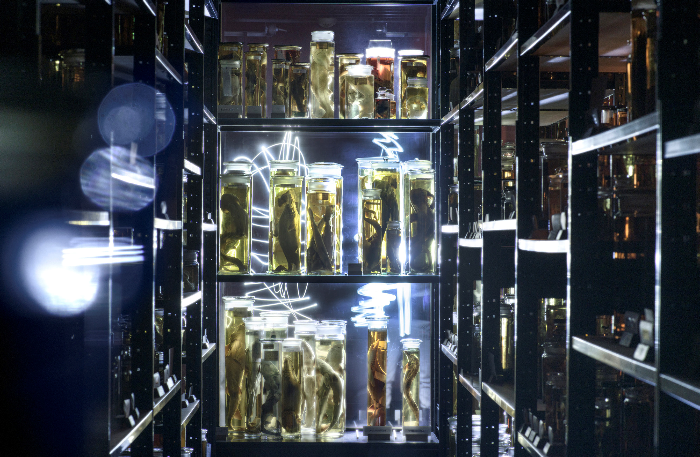Press Release
What drives someone to wait for hours for the chance to observe a particular animal or spend years traveling through foreign countries to collect plants, or rocks? The desire to explore these motivations inspired Mark Dion’s artistic intervention Collectors Collected. The Material Culture of Field Work at the Museum für Naturkunde Berlin. He looks at the scientists who have gathered objects for the museum’s collections, much like an anthropologist studies a foreign culture.

Kunst/Natur, Artistic Interventions Round IV
Museum für Naturkunde, Berlin (Germany)
30.01 - 29.04.2018

Exhibition January 30 -

© ArtCatalyse International / Marika Prévosto 2018. All Rights Reserved
Mark Dion focuses on materials used outside for work “in the field.” In doing so, he asks how these objects provide information about the technological, political, historical, and economic aspects of scientific work.
Curator: Christine Heidemann, Berlin
Mark Dion (b. 1961 in New Bedford, Massachusetts, based in New York) has been working since the 1980s on our relationship to nature in science and art. He has exhibited internationally, at venues including the Natural History Museum in London (2007), documenta 13 in Kassel (2012), the Istanbul Biennale, and the ICA Boston (both 2017).
Assaf Gruber’s artworks often deal with the interplay between people’s ideologies and their life stories, and with the way in which they shape and influence private and public spheres and relationships. This was also the theme of his film installation The Conspicuous Parts. The film challenges the ways in which museums represent and communicate scientific facts or assumptions. The life stories of the protagonists—a taxidermist and writer working at the museum—elucidate how the presentation of those facts is shaped by the desires of individuals.
Curator: Dorothée Brill, Berlin
Assaf Gruber's (b. 1980 in Jerusalem, based in Berlin) film work stems from an abstract yet concrete sculptural practice that engages with the narrative expressiveness of objects, and draws attention to narrative sculptural encounters in still and moving images. His solo exhibitions include The Anonymity of the Night at the Muzeum Sztuki w Łodzi in Lodz, Citizen in the Making at Eigen+Art Lab in Berlin, and Rumor at Ujazdowski Castle Centre for Contemporary Art in Warsaw (upcoming).
Elizabeth Price’s BERLINWAL is made from objects and spaces of the natural history museum itself. The artist re-
Curator: Bergit Arends, London
Elizabeth Price (b. 1966 in Bradford, UK) was awarded the prestigious Turner Prize and the Paul Hamlyn Award, both in 2012. Her recent works include A RESTORATION (2016) at the Ashmolean Museum in Oxford, and the curated exhibition In a Dream You Saw a Way to Survive and You Were Full of Joy (2016/17). Price lives and works in London.
With her poetic opera Rete Mirabile | Wundernetz, Ulrike Haage brings new life to the museum’s wet collections. The composer translated her exploration of the space’s material and history into an associative fabric of sound. The audience experiences the work, which oscillates between minimal music and imaginative echoes of renaissance music, while moving with the singers and musicians through the collections. Mark Ravenhill’s libretto plays with images from Vampyroteuthis infernalis, an essay by Vilém Flusser on the vampire squid’s experience of the world. He approaches the material poetically, critically and symbolically. The micro-
The work of composer, pianist, and director Ulrike Haage (b. 1957 in Kassel, Germany; based in Berlin) combines jazz, avant-
Art/Nature. Artistic Interventions at the Museum für Naturkunde Berlin is an international pilot project co-

Light experiments for the micro-